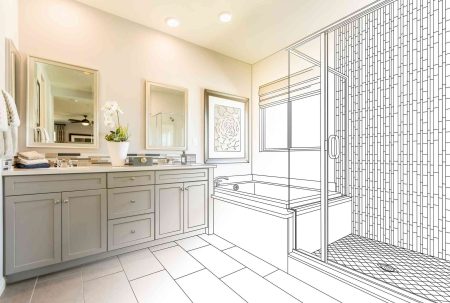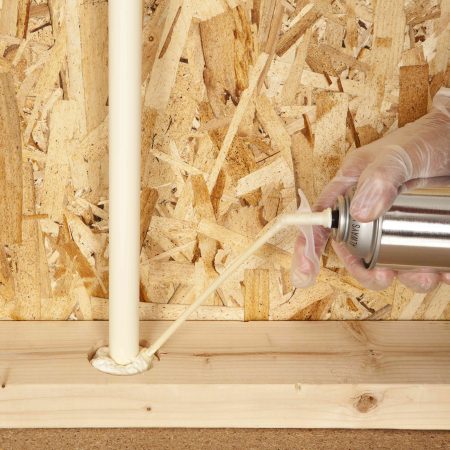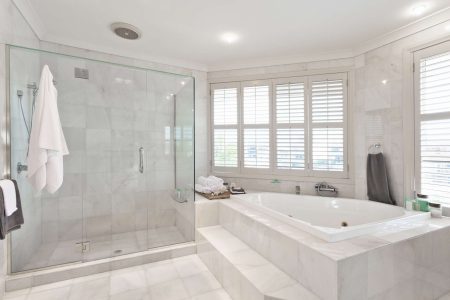Garage doors don’t just protect vehicles—they also strongly define a home’s exterior look. Learn about the main types of garage doors for a door that will deliver the most curb appeal while keeping your vehicles clean and secure.
Sectional Garage Door
A sectional garage door is comprised of four or five horizontally oriented panels connected with hinges. Once the garage door opener activates, the door slides up a curved track into the garage. When open, the door remains about 7 feet above the garage floor.
A torsion spring above the garage door assists with lifting the door. These doors are so heavy that the garage door opener alone cannot lift them.
Sectional garage doors tend to be less expensive than other types. Most garage doors at local home centers are sectional doors. These doors are secure because it is difficult to break between the panels.
Sectional garage doors are heavy and dangerous to open manually. Also, sectional garage doors have many moving parts—the torsion spring, rollers, bolts, hinges, and more. All of these moving parts need to be kept clean and well-lubricated.
-
Lower cost
-
Availability
-
Secure
-
Frequent maintenance
-
Difficult manual operation
-
Complicated installation
Want more home reno project tips and inspiration? Sign up for our free daily newsletter for the latest how-tos, reno guides, and more!
Tilt Up or Canopy Garage Door
A tilt-up, canopy, or single-panel garage door is a single flat panel made of metal or wood that tilts upward. For balance, the hinges are roughly midpoint vertical instead of at the top.
Tilt-up garage doors, popular in the first half of the 20th century, retain a distinct vintage appeal for many homeowners.
Tilt-up garage doors are easy to open by hand. Not only do they have less weight in the door panel itself, but the panel is well-balanced to aid in lifting from the outside.
Clearance inside and outside the garage is the main issue with tilt-up garage doors. At the front, in the driveway, the door needs 3 to 4 feet of clearance to tilt up. About a third of the door remains outside the garage when the door is open.
If security is an issue, a tilt-up garage door may not be the best option since it can be forced open from the bottom. However, some manufacturers offer a two-point locking system that keeps the door safer.
One advantage of a sectional versus a single-panel tilt-up garage door is that if a part of the sectional door becomes damaged, it can be removed and replaced. If a single-panel tilt-up door becomes damaged, the entire door often needs to be replaced.
-
Simplicity
-
Vintage look
-
Easy to repair
-
Large driveway clearance
-
Less secure
-
Interior space limitations
Rollup Garage Door
With a rollup garage door, the flexible sheet of steel curls around a spring-loaded shaft when the door is open. So, rather than lying flat over the top of the garage floor, the sheet is tightly coiled into a cylinder at the front of the door.
Rollup garage doors are often found on commercial buildings. They are extremely strong and secure, and they preserve most of the garage’s ceiling space.
One downside of rollup garage doors is their appearance. While some have a sleek, industrial chic look, others look sterile and bland. Rollup garage doors are difficult to customize, and they do not have much space for windows.
-
Space-efficient
-
Durable
-
Secure
-
Difficult to customize
-
Professional installation
-
Limited window space
Hinged Garage Door
Hinged garage doors, sometimes called side-hinged, carriage, or barn doors, have two doors that meet in the middle, each with hinges on the sides. The doors open manually, just like barn doors.
Unlike sectional garage doors, hinged doors have no internal track and require no garage door opener. Since the doors open outward, the inside of the garage is kept open and free. Ceiling storage racks can be installed up to the garage door opening.
The classic look of hinged garage doors means they lend themselves well to numerous hinge, handle, and lock choices. They can be painted with ordinary exterior acrylic-latex paint.
Garage doors that open outward require driveway clearance of at least 5 feet to allow the doors to open.
Automatic outswing operators (openers) are expensive, ranging from $700 to $2,000, not including installation.
-
Keeps garage clear
-
Easy to repair
-
Customizable
-
Repainting required
-
Driveway clearance needed
-
Expensive opener
Retractable Tilt-Up Garage Door
A retractable tilt-up garage door, sometimes called an up-and-over garage door, has a single panel that tilts up and slides over the door on a set of parallel tracks.
The retractable mechanism keeps the door out of the way in the garage and saves space in the driveway. Unlike a tilt-up/canopy door, which protrudes in the driveway when open, no part of a retractable tilt-up door extends into the driveway.
It can be opened either manually or with an electric garage door opener. This door opens smoothly and typically opens and closes quietly.
Though this store is expensive, it is highly secure and durable. To allow the door panel to tilt upward, extra vertical room in the garage is required.
-
No protruding canopy
-
Good for smaller spaces
-
Secure
-
Requires a high ceiling
-
Professional installation
-
Expensive
Side-Sliding Garage Door
A side-sliding or slide-to-the-side garage door has vertically oriented panels that wrap around the inside wall of the garage when open.
Operating like a curtain, the door moves on a track mounted above the garage door, which continues along one of the garage walls.
A second rail, anchored to the floor, keeps the garage door moving without swinging. It also prevents intruders from pushing through the bottom of the door when it’s closed.
A side-sliding door requires no torsion springs, which are difficult and dangerous to install and maintain. The garage ceiling is left completely free for storage racks. The trade-off, though, is the loss of one of the garage walls for storage.
-
Ceiling space left free
-
Ability to open one side only
-
No spring mechanism
-
Loss of wall space
-
Expensive
-
Specialized installation
Garage Door Styles
Most garage doors fall into one of three style categories: classic, modern, or carriage house.
Classic
Classic or traditional garage doors are characterized by symmetrical raised panels.
This garage door has a clean appearance but is balanced out with enough ornamentation to look classic. Attractive and unfussy, it complements most home styles.
Classic door styles come in steel and fiberglass. Either material can be non-insulated or insulated.
Modern
Modern or contemporary garage doors are smooth and coolly functional, with little ornamentation. They emphasize colors and materials more than showy textures.
Modern garage doors are great for updating a mid-century modern home or for building an entirely new contemporary home.
Steel, aluminum, glass, and sometimes touches of finished wood combine to lend an air of serenity to a contemporary home’s exterior.
Carriage House
Carriage house or barn-style garage doors have two side-hinged doors that meet in the middle.
For a farmhouse-style home, it can look very rustic, with roughly finished wood and diagonal braces, or it can mesh with the more refined décor of a Craftsman-style home, with strong vertical door stiles and horizontal rails.
Carriage house garage doors are always wood or wood-look, but they can have small glass windows and many are embellished with bronze or painted black steel handles and hinges.
Garage Door Sizes
Garage door sizes range from 8 feet to 20 feet wide. Single-vehicle garage doors are 8 to 10 feet wide, and double-vehicle garage doors are 12 to 20 feet wide.
Garage door heights are usually 7 feet high, but 8- and 10-foot heights are available, too.
Single Garage Door Sizes
| Width (Feet) | Height (Feet) |
| 8 | 7 |
| 9 | 7 |
| 10 | 7 |
| 8 | 8 |
| 9 | 8 |
| 10 | 8 |
| 9 | 10 |
| 10 | 10 |
Double Garage Door Sizes
| Width (Feet) | Height (Feet) |
| 12 | 7 |
| 14 | 7 |
| 16 | 7 |
| 18 | 7 |
| 20 | 7 |
| 14 | 8 |
| 16 | 8 |
| 18 | 8 |
| 20 | 8 |
| 14 | 9 |
| 16 | 9 |
| 18 | 9 |
| 20 | 9 |
| 14 | 10 |
| 16 | 10 |
| 18 | 10 |
| 20 | 10 |
Read the full article here














